| (insert your NIE or newspaper logo here) |
Weekly Online LessonOnline Lesson ArchiveGrade Level: 6-12
|
Land of the Ainu
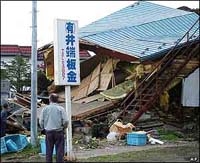 Strong
aftershocks shook Japan's northern island of Hokkaido early Saturday,
September 27, 2003.
Strong
aftershocks shook Japan's northern island of Hokkaido early Saturday,
September 27, 2003.
The 6-magnitude aftershock, followed Friday's magnitude-8 quake about 60 miles off the island's eastern shore. Japan is an earthquake-prone country due to its geological location and the movements of tectonic plates.
The island of Hokkaido is not only a land of earthquakes and volcanoes, however. It is also the homeland of an ancient people called the Ainu (pronounced "eye-nu").
Although the Ainu have lived in this region for thousands of years, they seem very little like their Asian neighbors in appearance, language, and cultural traditions. In fact, their mix of European and Asian physical traits contrast so sharply from other indigenous peoples of Asia that no one is really sure of their origin.
For this week's lesson, you'll meet the Ainu people and get a glimpse into their unique culture that's evolved on Hokkaido over the centuries.
Spirit of a Northern People
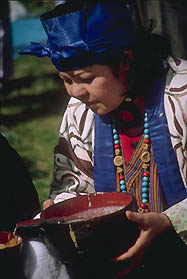 Your
virtual trip to Hokkaido begins at the Smithsonian's Arctic
Studies Center, specifically at the exhibit called, Ainu:
Spirit of a Northern People.
Your
virtual trip to Hokkaido begins at the Smithsonian's Arctic
Studies Center, specifically at the exhibit called, Ainu:
Spirit of a Northern People.
If you have a Flash player installed, then Enter the exhibit. This will pop open an interactive window. If you also have speakers hooked up, you'll be able to hear, as well as read, each room's overview. Thumbnails highlighting a room's contents can be clicked on to view text explaining each artifact. Video commentaries, noted with a video icon, offer great explanations of both artifacts and traditions. (If you don't have speakers, you can still read the video transcripts).
If you don't have Flash installed, browse the exhibit through its plain text version.
The exhibit provides seven thematic rooms to tour. After experiencing or skipping the site's Introduction, the video overview of Room 1— Faces of Ainu will play. After hearing or reading the overview, browse the room's collection.
What does "ainu" mean? Who were the Jomon and how do they relate to the Ainu? How do the commentators explain the Ainu's origins?
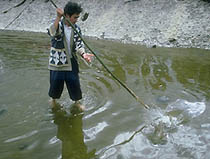 Move
on to the Next Room, A People's Past,
and browse this exhibit room as you did Room 1.
Move
on to the Next Room, A People's Past,
and browse this exhibit room as you did Room 1.
In what ways did the Ainu influence trade in their region? How do the artifacts, such as the sealskin boots and the twined basket, illustrate their connections to other cultures in the North Pacific?
What happened in the 18th and 19th centuries that significantly changed how the Ainu lived and interacted with their neighbors? How did those changes affect their cultural traditions?
Room 3, A Life Guided by Kamuy, explains how the natural world influences Ainu life. The overview, for example, says that everything in the natural world represents what to the Ainu? How does this belief shape their art, like the carvings on their knives, as well as the materials they traditionally used for their tools and clothing?
When you enter Room 4, Chise: the Ainu House, you get a sense of how Ainu have traditionally lived. Why was the fireplace an important aspect of the chise?
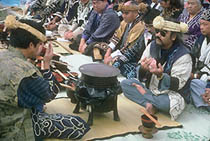 In
the next room, you'll get A Vital Cultural Look at
the ceremonies of the Ainu. How has the bear ceremony changed in recent
years and why? What is the importance and function of prayer sticks?
In
the next room, you'll get A Vital Cultural Look at
the ceremonies of the Ainu. How has the bear ceremony changed in recent
years and why? What is the importance and function of prayer sticks?
In the exhibit's last two rooms, Rising from Adversity and Renewal, you'll see examples of how the Ainu culture has evolved to interact with the contemporary world yet keep intact their unique identity.
How did tough economic times affect Ainu traditions? Why was this transition difficult but necessary for their survival as a people?
The Animal Spirits
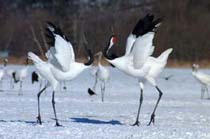 As
you've seen, animals played important roles in Ainu life. So to top
off your exploration of Ainu culture, stop by NOVA's companion site
to the film, Island
of the Spirits.
As
you've seen, animals played important roles in Ainu life. So to top
off your exploration of Ainu culture, stop by NOVA's companion site
to the film, Island
of the Spirits.
Spend some time reading the Ainu Legends. Read through all of them, if you have time, from the Water-wagtail to the Water-ouzel. Or, using the thumbnail gallery, choose a few that you're most interested in, like maybe the Otter, Bear, Little Horned Owl, Salmon, or Crane.
How does each animal's natural behavior relate to the Ainu's belief or use of that animal? Why do you think such stories were created and have been kept alive through the generations?
Do you know of any other traditional cultures that believe animals are spiritually important in similar ways? If so, do you think any of those other cultures had contact with the Ainu before the 18th century (which may have influenced the cultures of both peoples), or do you think these cultures developed similar belief systems independently?
Newspaper Activities
In current issues of Targetnewspaper, look for stories about traditional cultures, whether based in Asia or the Americas. How is that culture's art and apparent belief system different from that of the Ainu? In what ways are the two cultures similar? How do you think the culture highlighted in the news story was influenced by their homeland's geography or ecology? How may it have been influenced by other cultures, like through exploration and trade?
© Copyright 2003
Learners Online, Inc.
